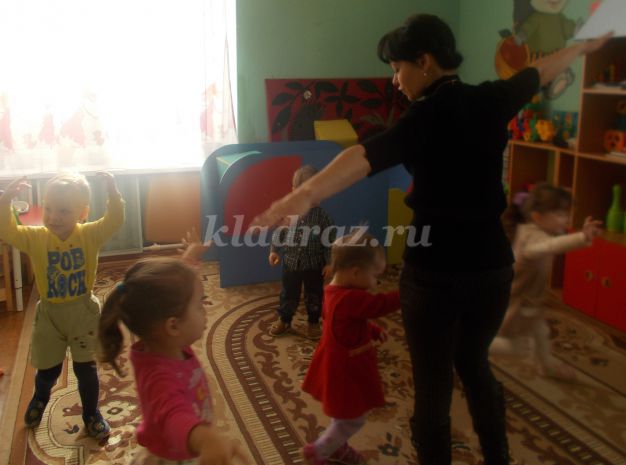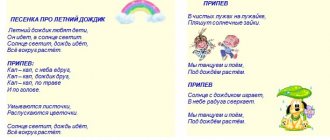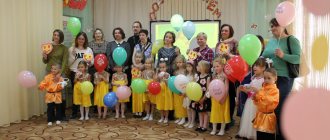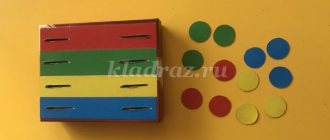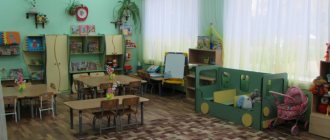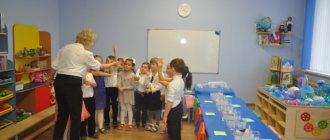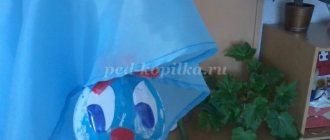Long-term entertainment plan for the first junior group
Entertainment plan for the first junior group
September
- "Guys' Holiday"
Goal: to put children in a good mood by listening and singing along to children's songs from cartoons. Offer to move to the music with handkerchiefs and rattles.
- "Funny toys"
Goal: developing children's knowledge about caring for toys and handling them correctly; learn to answer questions based on the text; create a good mood, a positive emotional state; enrich your vocabulary.
- Video library. Fairy tale "Ryaba Hen"
Goal: to put children in a good mood from watching a presentation of a fairy tale. Learn to answer questions. Offer to mold the grains for the chicken. Cultivate a love for Russian folklore.
- physical education "Visiting the bear"
Goal: to exercise children in walking and running. Improve crawling and jumping skills. Continue to expand children's knowledge about autumn. Give children a feeling of joy.
October
1. “Visiting the bear”
Goal: to exercise children in walking and running. Improve crawling and jumping skills. Continue to expand children's knowledge about autumn. Give children a feeling of joy.
2.
Video library.
Fairy tale “Turnip” Purpose: to put children in a good mood from watching the presentation of the fairy tale. Learn to answer questions. Offer to build a path of bricks for the woman and grandfather.
3. Musical and theatrical “Cat with Kittens”
Goal: to make children want to emotionally interact with adults. Encourage children to actively participate in the activity. Continue to introduce the habits of cats and kittens.
- Musical and theatrical “The doll Masha has a birthday”
Goal: to help children remember the sequence of dressing and feeding. Continue introducing the names of cookware. Develop interest in play. Cultivate a caring attitude towards the doll.
November
- Physical education "Our Teremok"
(Kolesnikova, p. 24) Purpose: To train children in running and jumping; stimulate speech activity. Foster a love of playing together.
(Kolesova, p. 24)
- Cognitive and research “Who came to visit?”
Goal: To awaken children's interest in small folk forms of oral folk art. Involve children in communication with adults and peers. Develop children's individual creative abilities through modeling. Consolidate knowledge of familiar nursery rhymes.
- Musical and theatrical "Russian Matryoshka"
Goal: To introduce children to Russian folk art using the example of folk toys. Evoke positive emotions. Encourage participation in games and round dances.
- “The kids congratulate mom”
Goal: To enrich children's musical experience. Create a joyful mood in them. Develop the ability to move rhythmically to music.
December
- Physical education and recreation “My funny ringing ball”
Goal: To develop endurance, muscle strength, and agility in children. Exercise children in performing movements with the ball. Act on a signal. Give children pleasure.
- Video library “Christmas tree in the forest”
Goal: To make children want to see a Christmas tree in the forest (using slides). Make you want to sing along to the song “Little Christmas Tree”. Develop musicality and sense of rhythm.
- Educational and research “Winter walk”
Goal: To consolidate children's knowledge about the winter season. Develop cognitive activity: find snow, ice. Learn to perform movements to music. Develop a sense of rhythm
- “Santa Claus brought a Christmas tree for the children”
January
- Physical education and recreation “Outdoors in winter”
Goal: to give children pleasure from playing outdoors. Exercise children in jumping up while reaching for an object. Develop the ability to throw snowballs into the distance with your right and left hands. Practice balance (stop quickly when given a signal). Develop dexterity and patience.
- Musical and theatrical “Farewell to the Christmas tree”
Goal: To make children want to have fun at the Christmas tree: sing songs, dance, play
- Educational and research “Pills grow on a branch, pills grow in a garden bed.”
Goal: To clarify children’s knowledge about vegetables and fruits, their qualities, to consolidate the ability to recognize them from a picture and give a short description.
February
- Musical and theatrical "About the red fox"
Goal: to make children want to sing and play with a fairy-tale character, to participate in the staging of the nursery rhyme “Once a fox went into the forest.” Develop perception, speech, communication skills
- "Funny toys."
Goal: to develop children’s knowledge about caring for toys and handling them correctly; learn to answer questions based on the text; create a good mood, a positive emotional state; enrich your vocabulary.
- “Visiting Alyonushka”
Goal: Continue to introduce children to Russian folklore. Make children want to play on wooden spoons and admire their beauty. Develop musical and rhythmic movements.
- Physical education “The locomotive hummed”
Goal: To develop in children the ability to play outdoor games, run fast, jump, and throw balls into the distance. Be dexterous and brave.
March
- Musical and theatrical Festival “Congratulations to Mommy”
Goal: to make children want to sing, play, have fun and congratulate their mother. Develop emotional responsiveness, enrich musical experience.
- Musical and theatrical “Grandma Arina came to visit us”
»
Goal: Create an atmosphere of joyful mood. Teach children to solve riddles, read poems and sing songs together with a fairy-tale character.
- Educational and research "Rainbow Holiday"
Goal: to bring joy to children, to cause a storm of emotions. Development of dexterity, coordination of movements, the ability to distinguish colors and the size of the number of objects (soap bubbles).
- Physical education "Visiting a fairy tale"
Goal: To make children want to be participants in fairy-tale events. Develop the ability to maintain a stable body position and correct posture;
April
- Musical and theatrical "April Fool's Day"
Goal: to evoke positive emotions, good mood. Teach children to play outdoor games together, jump, run, without bumping into each other. Develop perception, coordination of movements, dexterity.
- Sports and recreational “Visiting the Hedgehog”
Purpose: to exercise children in walking and running; improve crawling and jumping skills; continue to expand children's knowledge about nature; give children a feeling of joy.
- Presentation of the fairy tale
“Kolobok”
Goal: to put children in a good mood from watching a presentation of a fairy tale. To teach them to answer questions. Offer to mold the grains for the chicken. Cultivate a love for Russian folklore.
- Cognitive and research “And on the hands there are fingers, girls and boys”
Goal: To involve children in communication with adults and peers. Develop children's individual creative abilities through modeling. Consolidate knowledge of familiar nursery rhymes.
May
- Musical and theatrical "Sunny Bunnies"
Goal: Develop communication skills. Continue to introduce basic rules of conduct, ethics of greeting and communication.
- Physical education and recreation “We grow healthy”
Goal: To evoke in children an emotional response to the gaming activity and a desire to participate in it. Teach children to play together. Teach more dexterous children to help other kids.
Teach children to sympathize and empathize with a fairy-tale character.
- Video library Fairy tale “Turnip”
Goal: to put children in a good mood from watching a presentation of a fairy tale. Learn to answer questions. Offer to build a bridge and a path to the woman and grandfather's house.
- Educational and research "Circus"
Goal: To learn to identify the features of objects and natural objects based on the techniques of sensory examination, comparison, elementary analysis and generalization. To promote mastery of various actions with objects. To promote the development of interest in participating in game improvisations.
Outdoor games for nursery and junior groups.
Outdoor games for children from 1.5 to 3 years old.
"Sunny bunnies"
Objectives: increase motor activity, develop dexterity; evoke positive emotions from the actions performed. Having gathered a group of children around him, the teacher uses a mirror to shoot sunbeams onto the wall and say: Sunbeams are playing on the wall, lure them with your finger, they will come running to you. After a pause, he gives the signal: “Catch bunnies!” Children run to the wall and try to catch the bunny slipping from under their hands.
"Catch the ball"
Objectives: to encourage action on a signal, to improve running in combination with actions, to enjoy joint actions. The teacher shows the children a basket with balls and invites them to stand next to him along one side of the playground. Then, with the words “catch up with the ball,” he throws them out of the basket, trying to make them roll in different directions, away from the children. Children run after the balls, take them and put them in the basket. The game repeats itself.
"Collect the balls"
Objectives: increase physical activity; contribute to the emergence of positive emotions from joint actions. For the game, balls (wooden or plastic) of different colors are selected. Having put them in a basket, the teacher invites the children to see how beautiful the balls are, telling them what color they are. Then he pours them out with the words: “That’s how the balls rolled... Catch up with them and put them back in the basket.” Children run after the balls and take them to the basket. When repeating the game, the teacher names who brought which ball: red, yellow, and so on. The teacher makes sure that the children do not bunch up, but run around the entire playground (each child runs at his own pace). At first, the game is played with a small group of children, gradually the number of players increases.
"Catch me"
Objectives: improve running in a certain direction; learn to navigate in space. “Catch up with me,” the teacher suggests and runs to the opposite wall of the room. Children run after the teacher, trying to catch him. Then the teacher again says: “Catch up with me,” and runs in the opposite direction, the children catch up with him again. After two runs, the children sit on chairs and relax. Then the game resumes. It is better to play the game with small groups of children: while one group of children plays, another watches, then the children change roles.
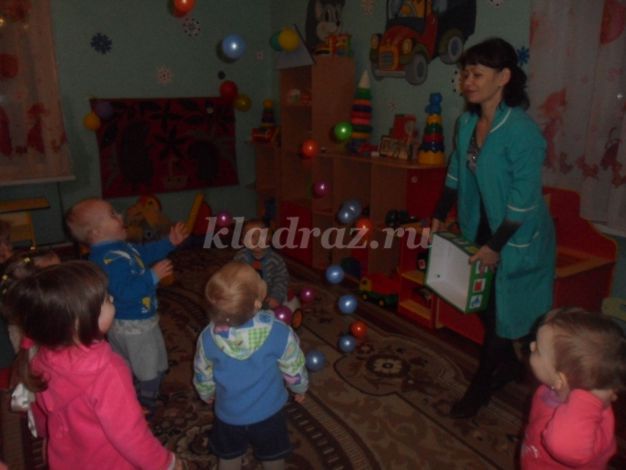
"Cat and Mice"
Objectives: increase physical activity; develop imitation movements; arouse interest and desire to perform actions in accordance with the text. The game is played with a small group of children in the playroom or on a walk. Using a cord, a place for mice is fenced off. A cat is chosen. She sits on a chair or stump. Mice sit in minks. The teacher says: The cat is guarding the mice, Pretending to be asleep. The mice crawl out of their holes and start running. After a while, the teacher says: Hush, mice, don’t make noise, you won’t wake up the cat…. This is a signal to the cat; she gets off the chair, gets on all fours, arches her back, loudly says “meow” and begins to catch the mice as they run into their holes. The game can be repeated 3-4 times, with other cats.
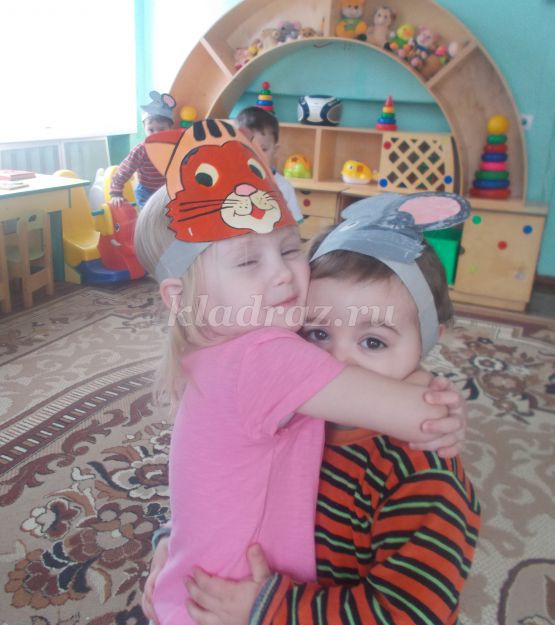
"Shaggy Dog"
Objectives: enrich motor experience; encourage children to follow the basic rules of the game; encourage independence; evoke a feeling of pleasure from communicating with adults and peers, as well as from performing movements. One of the children portrays a dog; he lies down on the mat, resting his head on his outstretched arms in front of him. The rest of the children quietly approach him, and the teacher at this time says: Here lies a shaggy dog, with his nose buried in his paws, Quietly, quietly, he lies, either dozing or sleeping. Let's go to him and wake him up
Advertisement 14
And we'll see if something happens. The dog jumps up and starts barking. The children run away. The dog is chasing them. When all the children run away and hide, the dog lies down on the rug again. The game is repeated with a new driver.
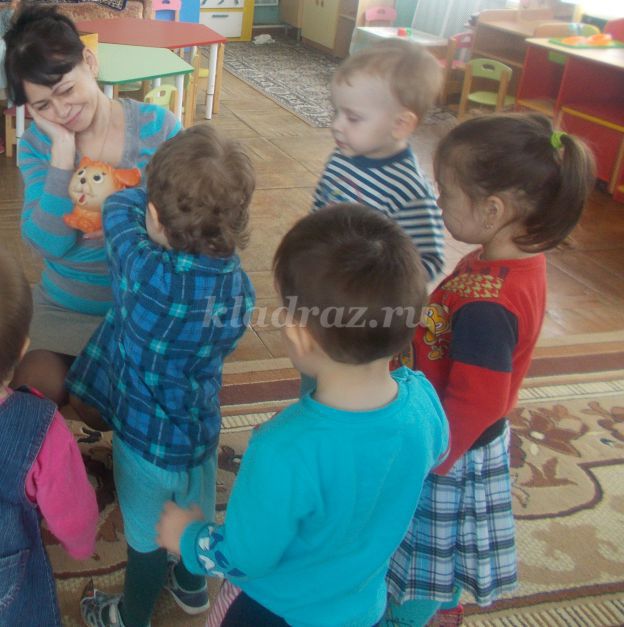
"By the Bear in the Forest"
Objectives: learn to act on the teacher’s signal, improve running in a certain direction; teach orientation in space One of the children depicts a bear; he sits on a chair, hands folded under his cheek, pretending to be asleep. The rest of the children quietly approach him, bending over, as if picking mushrooms and berries, and at this time the teacher says: From the bear in the forest, I take mushrooms and berries, But the bear does not sleep, He keeps looking at me. And then he growls. And he will run after us. The bear jumps up and runs after the children. The children run away. The bear is chasing them. When all the children run away and hide, the bear sits down on the chair again. The game is repeated with a new driver.

"Chicks and the Cat"
Objectives: improve running; develop the ability to imitate, be attentive and act on a signal; encourage independent action; evoke a feeling of joy from joint actions, teach children to run in a certain direction. The teacher depicts a chicken, the children - chickens. A cat is selected as a counting machine. The cat sits on a chair to the side. The hen and chicks walk around the room. The teacher says: A crested hen came out, There are yellow chicks with her, The hen clucks: “Ko-ko, Don’t go far.” Approaching the cat, the teacher says: On the bench by the path, the cat has laid down and is dozing... The cat opens its eyes and catches up with the chickens. The cat opens its eyes, meows and runs after the chickens, which run away to a certain corner of the room - the “house”, to the mother hen. The teacher (chicken) protects the chickens, spreading his arms to the sides, and says at the same time: “Go away, cat, I won’t give you chickens!”
"Sun and Rain"
Objectives: to develop in children the ability to run in all directions without bumping into each other, to quickly respond to a signal, to teach them to carry out actions according to an adult’s word; encourage children's independence and initiative; evoke a feeling of joy from joint actions. Children squat down behind the chairs, located at some distance from the edge of the platform or the wall of the room, and look out the “window” (into the hole in the back of the chair). The teacher says: “The sun is in the sky! You can go for a walk." Children run all over the playground. To the signal: “Rain! Hurry home! — run to their seats and sit behind the chairs. The teacher says again: “Sunny! Go for a walk,” and the game repeats.
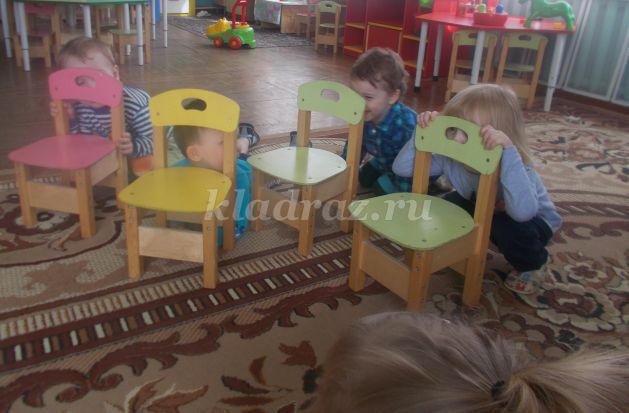
"Blow up the bubble"
Objectives: encourage children to act in accordance with words; learn to coordinate your actions with the actions of other children; consolidate the ability to stand in a circle, gradually expanding and narrowing it; develop physical activity. Children stand close together in a circle, holding hands. Together with the teacher they say: Blow up, bubble, Blow up big, Stay like that, Don’t burst. By reciting poems, children gradually expand the circle. When the teacher says: “The bubble has burst,” all the children lower their hands, saying in unison: “Pop,” and squat down. The teacher offers to inflate a new bubble: the children stand up, form a small circle again, and the game resumes.
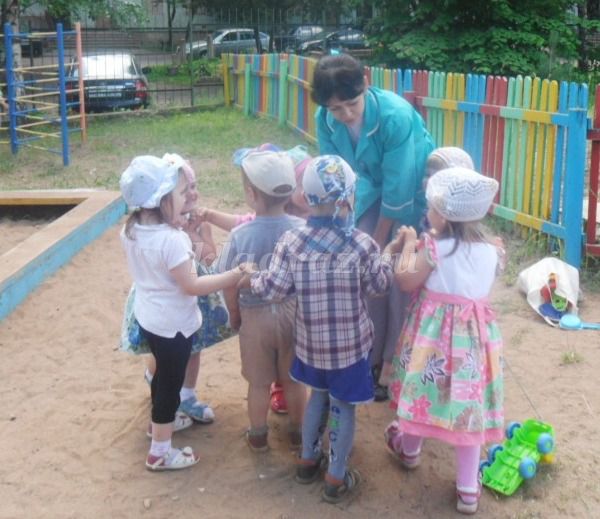
"Train"
Objectives: teach to move in a certain direction, coordinate actions with other children, encourage independent actions. The teacher offers to play “train”: “I will be the locomotive, and you will be the carriages.” Children stand in a column one after another, holding onto the clothes of the person in front. “Let’s go,” says the teacher, and everyone begins to move, saying: “Choo-Choo.” The teacher drives the train in one direction, then in the other, then slows down, finally stops and says: “Stop.” After a while, the whistle sounds again, and the train sets off again. Where is the bell hiding? Objectives: learn to navigate in space; develop the ability to run in different directions; evoke a feeling of joy from joint actions.
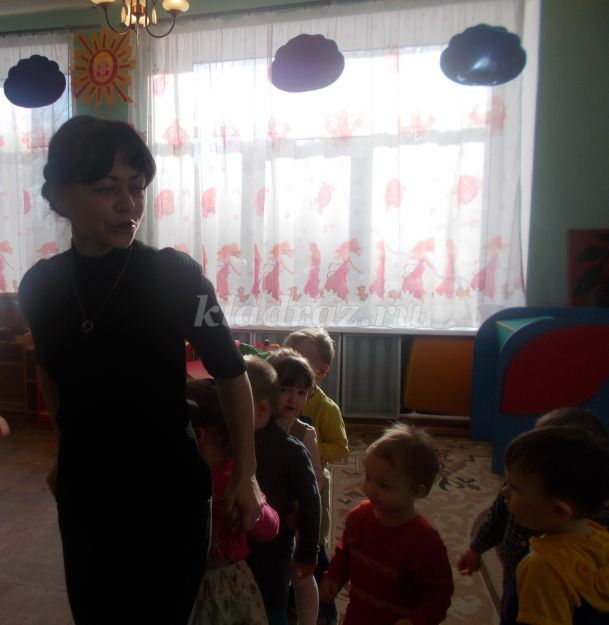
Children stand facing the wall. The nanny hides at the other end of the room and rings the bell. The teacher tells the children: “Listen to where the bell is ringing and find the bell.” When the children find the bell, the teacher praises them and then asks them to turn to the wall again. The nanny rings the bell again, hiding in a different place.
"My funny ringing ball"
Objectives: teach children to jump on two legs; learn to listen carefully to the text; evoke a feeling of joy from active actions. Children sit on chairs placed in different places in the room. The teacher is in the center. He takes a large ball and begins to hit it with his hand on the ground, saying: “My cheerful, ringing ball...”. The teacher calls the children to him and invites them to jump like balls. Children jump at the same pace. The teacher puts the ball down and repeats the poem, moving his hand as if he were hitting the ball, and the children jump. Having finished the poem, the teacher says: “I’ll catch up!” The children run away.
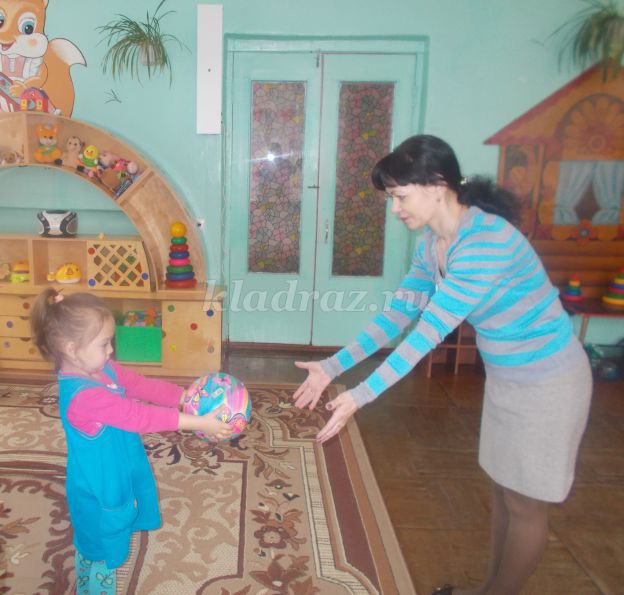
"The little white bunny is sitting"
Objectives: improve running; develop the ability to imitate, be attentive and act on a signal; encourage independent action; evoke a feeling of joy from joint actions. On one side of the site the places of the hares are marked. Everyone falls into place. At the teacher’s signal “Run in a circle!” all the children gather in a circle, and one of the hares, whom the teacher appoints, stands in the middle. Children with a teacher recite poems and perform movements to the text: The little white bunny sits and wiggles his ears - the children stand in a circle, Like this, this is how he wiggles his ears! – move their hands, raising them to the head. It’s cold for the bunny to sit, he needs to warm his paws, Clap-clap, clap-clap, he needs to warm his paws - they clap their hands. It’s cold for the bunny to stand, the bunny needs to jump hop-hop, hop-hop, hop-hop, the bunny needs to jump - they jump on 2 legs in place. Someone scared the bunny, the bunny jumped and galloped away! – the teacher claps his hands, the children run away to their homes.

"Birds in Nests"
Objectives: enrich motor experience; encourage children to follow the basic rules of the game; encourage independence; evoke a feeling of pleasure from communicating with adults and peers, as well as from performing movements. On one side of the playground, hoops (“nests”) are laid out freely according to the number of children. Each child (“bird”) stands in his own “nest”. At the teacher’s signal, the children - “birds” run out of the hoops - “nests” - and scatter throughout the entire playground. The teacher imitates feeding the “birds” at one or the other end of the playground: the children squat down, hitting their knees with their fingertips - they “peck” at the food. “The birds have flown to their nests!” - says the teacher, the children run to the hoops and stand in any free hoop. The game is repeated, jump twice.
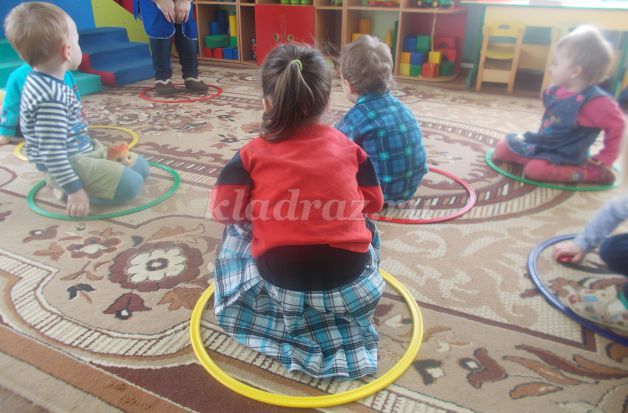
"Geese - geese"
Objectives: improve running in combination with hand actions; evoke a need to imitate; enjoy joint activities. Children pretend to be geese, standing at one end of the room, and an adult stands at the other end. They take turns saying: Adult: Geese, geese! Children: Ha-ha-ga! Adult: Do you want something to eat? Children: Yes, yes, yes! Adult: Come to me! The geese children fly towards the adult, flapping their wings, hissing: “Sh-sh-sh.” Then the adult says: “Ksh! Run into the field!” The geese run back to their place.
"Birds and Cars"
Objectives: improve walking in different directions, on a limited surface; develop attention and the ability to respond to signals; encourage active interaction with peers. All children pretend to be birds. The role of the car is initially played by the teacher. He says: “The birds have flown out for a walk.” Bird children fly around the group, flapping their wings, pecking at grains. At the teacher’s signal “Car!” The birds quickly run away from the road. One part of the children is placed on one side of the group; the playgrounds are birds. On the other side there is another part of the children - these are cars. The teacher says: “The birds are flying!” — the birds fly, flap their wings, squat, peck grains. At the signal “Cars have left!” children pretending to be cars drive onto the road, and birds fly away to their nests. Cars drive along the road, avoiding obstacles (benches, cubes). When repeating the game, children change roles.
"Carousels"
Objectives: develop balance, learn to coordinate your actions with the words of the text, with movements with each other and the rhythm of the text; develop attention; evoke positive emotions. Children take hold of the hoop and, following the words of the teacher, move in a circle, first slowly, then faster and faster, and then gradually slow down. Barely, barely, barely, barely The carousel spun, And then, then, then Everyone ran, ran, ran. Hush, hush, don't rush, stop the carousel. One-two, one-two, The game is over.

"Present"
Objectives: to cultivate friendly, benevolent relationships; learn to imitate movements characteristic of a particular toy; develop imagination. The teacher invites the children to form a circle and calls to him the one who will be the first to choose a toy. The child goes to the middle of the circle, and the teacher and the children dance in a circle to the words: We brought you gifts, Whoever wants it will take it, Here is a doll with a bright bow, A horse, a top and an airplane. When the words end, the children stop. The teacher turns to the child in the center of the circle and asks which gift (from those listed) he wants to receive. If he chooses a horse, then all the children, following the words of the teacher (our horse gallops chok-chok-chok, you can hear the clatter of fast legs), pretend to be a horse (jump), if a doll, then everyone dances like dolls (doll. Doll dance, wave a bright ribbon ) if the top (this is how a top spins, it buzzes and rolls) - everyone spins. The teacher invites the child to choose the best “gift” from among the children. The selected child changes the previous one in the center and the game repeats.
